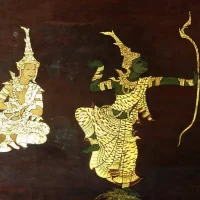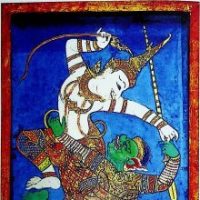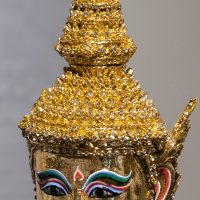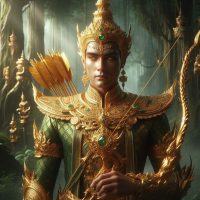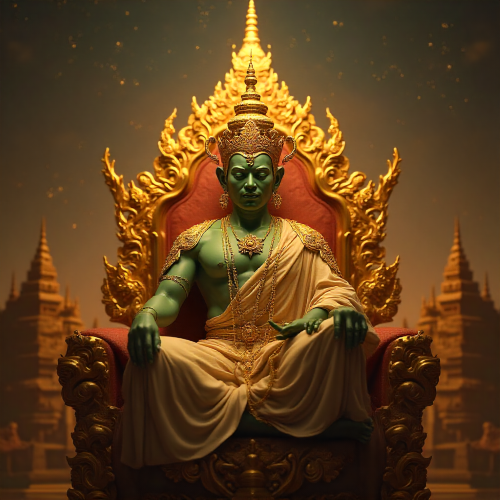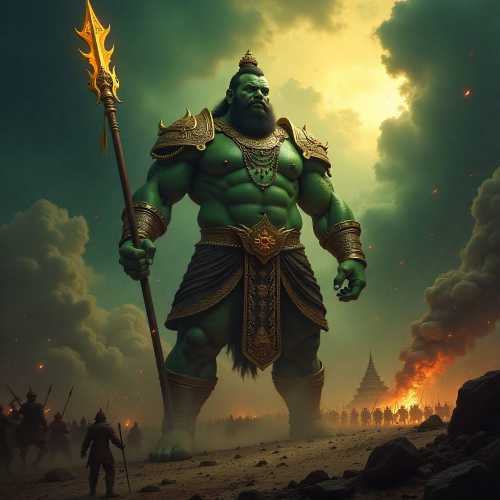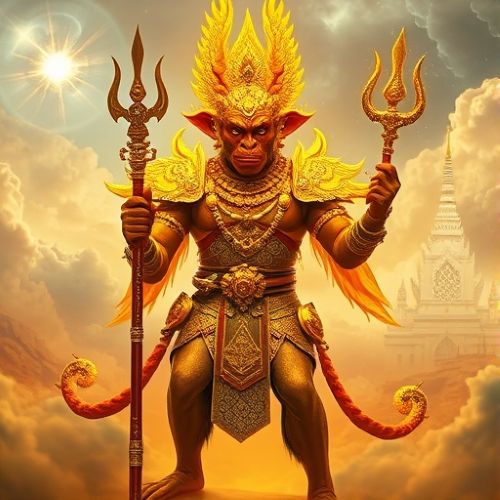Phra Lak : The Loyal Brother
Listen
At a glance
| Description | |
|---|---|
| Origin | Thai Mythology |
| Classification | Demigods |
| Family Members | Phra Ram (Brother) |
| Region | Thailand |
| Associated With | Loyalty, Warfare |
Phra Lak
Introduction
Phra Lak (พระลักษณ์) stands as one of the most honored heroes in Thai mythology and occupies a vital role in Ramakien, Thailand’s grand national epic derived from the Indian Ramayana. As the loyal brother of Phra Ram (Rama), Phra Lak is celebrated for his steadfast devotion, courage, and righteousness. His unwavering commitment to his brother and his moral strength have made him a timeless emblem of fraternal fidelity and virtuous conduct. The Ramakien, while mirroring the structure of the Ramayana, imbues Phra Lak’s character with distinctly Thai cultural nuances, portraying him not merely as a supporting hero but as the embodiment of loyalty and selflessness in the face of moral and spiritual challenges.
Physical Traits
Phra Lak is portrayed as a handsome and noble warrior, radiant with divine grace. His golden complexion signifies purity and celestial favor, setting him apart as a being of higher moral and spiritual standing. In Thai murals and Khon dance dramas, Phra Lak is usually adorned in regal attire, with intricate gold and green patterns symbolizing valor and protection. His elaborate headgear, patterned armor, and weaponry—most notably his bow and arrow—underscore his readiness for battle and his role as protector of Phra Ram and Nang Sida (Sita). His posture and expression are typically calm yet vigilant, reflecting both his disciplined warrior spirit and his inner harmony. Unlike Phra Ram, whose demeanor often conveys serenity and divine detachment, Phra Lak exudes youthful energy and a deeply human passion for justice and kinship.
Family
Phra Lak is the son of King Thotsarot (Dasaratha) and Queen Kaosuriya (Kausalya) and the younger brother of Phra Ram, who represents the divine incarnation of Vishnu in the Thai retelling. He also shares kinship with Phra Satrud, another brother, and Nang Sida, whose abduction by the demon king Thotsakan (Ravana) drives the central conflict of the Ramakien. The familial ties within this royal household are deeply symbolic, representing the harmony between virtue, duty, and love. Phra Lak’s selfless decision to accompany Phra Ram during his exile illustrates the profound Thai value of kreng jai—a cultural principle emphasizing respect, compassion, and moral responsibility within relationships. His unyielding support during their trials reinforces the notion that brotherhood transcends personal comfort and ambition, serving instead as a sacred moral bond.
Other names
Phra Lak’s name is the Thai adaptation of the Sanskrit Lakshmana, the loyal brother of Rama in the Ramayana. While his essence remains consistent with the original character, the Thai reinterpretation enriches his persona with Buddhist undertones and localized virtues. In some adaptations, he is depicted as embodying the qualities of a bodhisattva, symbolizing the path of compassion and sacrifice. The Laotian version of the epic, Phra Lak Phra Ram, further demonstrates his regional influence, portraying him as an equally divine companion whose existence completes the moral and spiritual balance of the story. In Thailand, his name “Phra” denotes reverence, underscoring his semi-divine status and continued veneration in cultural and religious expressions.
Powers and Abilities
Phra Lak is revered not only for his skill in combat but for his unwavering ethical and spiritual strength. He is a master archer, capable of extraordinary precision and power, often credited with defeating formidable demons through both martial skill and strategic wisdom. His abilities extend beyond physical prowess—he embodies protective magic that serves as both a literal and symbolic defense for Phra Ram and Nang Sida. Thai interpretations of the Ramakien often highlight his tactical intelligence, moral clarity, and emotional control, qualities that allow him to navigate both battlefield challenges and moral conflicts. His true power, however, lies in his steadfast devotion and adherence to dharma (righteousness). Even when faced with temptation, injustice, or despair, Phra Lak remains unwavering, making him not only a hero of action but also a paragon of moral endurance. His strength represents the ideal Thai virtue of khun, a combination of honor, duty, and moral excellence that transcends time.
Modern Day Influence
Phra Lak continues to play an influential role in Thailand’s cultural identity, extending far beyond mythology into art, performance, and education. In Khon masked dance performances, his character is marked by deliberate, graceful movements that signify controlled power and refined discipline—an embodiment of the Thai warrior’s spirit. His image also adorns temple murals across the nation, most notably at Wat Phra Kaew (Temple of the Emerald Buddha) in Bangkok, where intricate depictions of the Ramakien immortalize his heroic deeds.
In modern literature and classrooms, Phra Lak is often held up as a moral exemplar for Thai youth, symbolizing selflessness and duty toward family and society. The story of Phra Lak and Phra Ram has also been retold through contemporary media, including animations, television adaptations, and graphic novels, introducing his virtues to younger generations in a relatable format. Beyond Thailand, in Laos and Cambodia, similar cultural traditions keep his legend alive, reaffirming his position as a shared hero in Southeast Asia’s mythological landscape.
In contemporary Thai society, Phra Lak’s narrative transcends religion and epic storytelling—he represents the moral fiber of collective life. Whether through temple rituals, state-sponsored performances, or modern artistic reinterpretations, his spirit continues to reinforce the enduring Thai belief that loyalty and righteousness form the foundation of both personal virtue and national harmony. His story bridges ancient Hindu mythology with Buddhist ethics, making him an eternal symbol of moral clarity and devotion within Southeast Asian cultural consciousness.
Related Images
Source
WikiWicca. (2021, September 6). The legend of Phra Lak, the golden deity. Retrieved November 4, 2025, from https://www.wikiwicca.com/legend-myths-and-origins/the-legend-of-phra-lak-the-golden-deity/
Fiveable. (2024, August 12). Phra Lak Phra Ram: Lao Dance-Drama. Retrieved November 4, 2025, from https://fiveable.me/music-and-theater-in-southeast-asia/unit-6/phra-lak-phra-ram-lao-dance-drama/study-guide/Tqvg20tLVrW0dXMN
Wikipedia contributors. (2005, June 8). Phra Lak Phra Ram. Wikipedia. Retrieved November 4, 2025, from https://en.wikipedia.org/wiki/Phra_Lak_Phra_Ram
Wisdom Library. (2025, February 14). Phra Lak definition. Retrieved November 4, 2025, from https://www.wisdomlib.org/definition/phra-lak
Wannaudorn, A., & Hongsuwan, C. (2014). Phra Lak Phra Lam: The representation of cultural beliefs in Lao literature. Journal of Lao Studies, 5(1). Retrieved November 4, 2025, from https://www.laostudies.org/system/files/subscription/JLS-v5-i1-Aug2014-Wannaudorn-Hongsuwan.pdf
Stengs, I. L. (2009). Worshipping the great moderniser: King Chulalongkorn, patron saint of the Tai middle class. Amsterdam University Press.
Klaibanmai, K. (2021). Interpersonal aspects of academic book reviews: A Thai-English comparative study [Unpublished thesis]. University of Huddersfield.
Sanskrit.nic.in. (n.d.). Digital book on ancient Indian history and Buddhism. Retrieved November 4, 2025, from https://www.sanskrit.nic.in/DigitalBook/S/sixty%20yearsvol1.pdf
Bunnag, T. (2000). Thai Classical Literature and the Ramakien. Bangkok: Chulalongkorn University Press.
Wyatt, D. K. (2003). Thailand: A Short History. Yale University Press.
Brandon, J. R. (1967). Theatre in Southeast Asia. Harvard University Press.
Boonchai, P. (2012). The Ramakien and Thai Identity. Journal of Southeast Asian Studies, 43(2), 215–230.
Srisakra, V. (1998). Thai Traditional Performing Arts and Mythology. Thai Cultural Institute Publications.
Frequently Asked Questions
What is lorem Ipsum?
I am text block. Click edit button to change this text. Lorem ipsum dolor sit amet, consectetur adipiscing elit. Ut elit tellus, luctus nec ullamcorper mattis, pulvinar dapibus leo.
What is lorem Ipsum?
I am text block. Click edit button to change this text. Lorem ipsum dolor sit amet, consectetur adipiscing elit. Ut elit tellus, luctus nec ullamcorper mattis, pulvinar dapibus leo.
What is lorem Ipsum?
I am text block. Click edit button to change this text. Lorem ipsum dolor sit amet, consectetur adipiscing elit. Ut elit tellus, luctus nec ullamcorper mattis, pulvinar dapibus leo.
What is lorem Ipsum?
I am text block. Click edit button to change this text. Lorem ipsum dolor sit amet, consectetur adipiscing elit. Ut elit tellus, luctus nec ullamcorper mattis, pulvinar dapibus leo.
What is lorem Ipsum?
I am text block. Click edit button to change this text. Lorem ipsum dolor sit amet, consectetur adipiscing elit. Ut elit tellus, luctus nec ullamcorper mattis, pulvinar dapibus leo.


